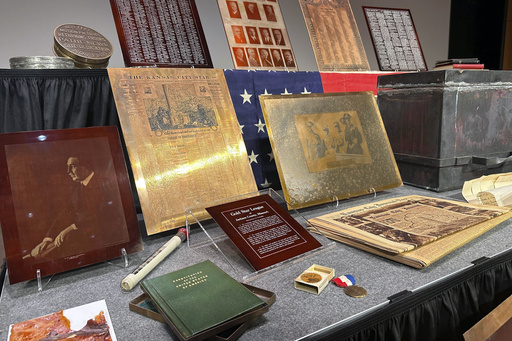
The unveiling of a time capsule, sealed away for a century inside one of the most notable World War I memorials in the United States, proved to be a challenge.
The first hurdle lay in accessing the time capsule, which was entombed within a 217-foot (66-meter) tall tower that dominates the Kansas City skyline, topped by an impressive flame.
Crews had to meticulously drill through 18 inches (45 centimeters) of concrete and limestone, as explained by Christopher Warren, the chief curator of the National World War I Museum and Memorial, during Wednesday’s ceremony.
“It was quite a task. There wasn’t a simple door to open and retrieve the capsule,” he noted.
Another significant concern arose from the type of film contained in the time capsule, which was produced in the 1920s and contained nitrate, a material that can become dangerously flammable as it deteriorates over time.
To ensure safety during the time capsule’s opening, a bomb squad from the police department was present.
“Thankfully, nothing ignited, which was a relief for preservation efforts. Perhaps it would have made for a more exciting story if there had been an explosion,” Warren remarked.
During the unveiling, he presented the audience, which included school children, with the carefully examined contents of the time capsule.
One particularly notable artifact was a letter from President Calvin Coolidge, in which he commended the community’s spirit. The Egyptian Revival-style memorial was constructed as a demonstration of postwar patriotism after a remarkable fundraising effort raised $2.5 million in under two weeks in 1919, a sum equivalent to around $45 million today.
This remarkable achievement prompted Allied military leaders from Belgium, Great Britain, Italy, France, and the United States to gather in 1921 for the dedication of the site where the time capsule was buried three years later.
The memorial is situated directly across from the Kansas City train station, a pivotal point through which more than half of the U.S. troops passed before embarking on their journeys overseas.
Currently, a museum is housed beneath the memorial.
The unveiling included a few surprises meant to engage the public, one of which was the first reading of a cursive note believed to be from General John J. Pershing, who commanded the American forces during the war.
However, the plan did not unfold as anticipated. The note clarified that while the time capsule committee had reached out to Pershing, they did not receive a direct response. Instead, they included excerpts from remarks he gave during the 1921 dedication ceremony.
“Ladies and gentlemen, do you know what this is? It’s essentially a 100-year-old automated out-of-office reply,” Warren quipped.
“General Pershing is currently on holiday but promises to reply to your email upon his return. That’s perfectly fine, as he remains an American hero.”
In light of the event, museum officials are already making plans to assemble a new time capsule for future generations.
